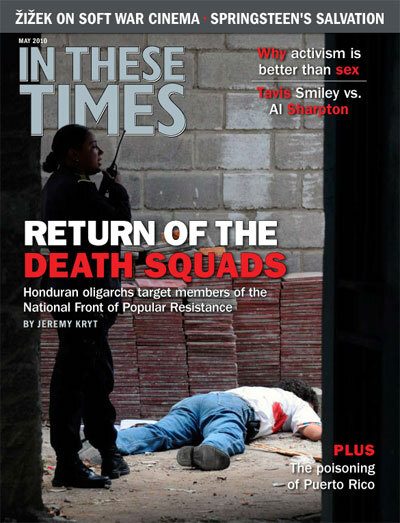
For decades now, Bruce Springsteen has used personal, individual stories as a way of getting at something much larger. In the worlds he constructs, a solitary soul searches for redemption in the mundane material of everyday life. The stakes are high. Meaning and hope and, indeed, our common fate hang in the balance. “I swear I found the key to the universe,” says the protagonist in the song “Growing Up,” “in the engine of an old parked car.”
Not everyone understands Springsteen’s project. Not everyone wants to. As David Masciotra notes in Working on a Dream: The Progressive Political Vision of Bruce Springsteen (Continuum, 2010), a majority of casual fans have almost no clue what the music is actually about. This is especially true of the album that made Springsteen an iconic figure in 1980s pop culture, Born in the U.S.A. You could dance to “Dancing in the Dark” or pump a fist to “Glory Days” without ever noticing the desperation and deep sadness pulsing through the lyrics. You could think that the title track was a tribute to American awesomeness – as Ronald Reagan did on the campaign trail in 1984, when the album was released – rather than a searing indictment of the cheap patriotism that Reagan peddled. “You end up like a dog that’s been beat too much,” says a returning Vietnam vet unable to find a job or a place in normal society. “‘Til you spend half your life just covering it up.”
In addition to legions of casual fans, there are of course many people for whom the music doesn’t mean anything. And there is a third category, the smallest but most interesting of the three. Some people – we might call them Springsteen believers – identify so closely with the music that it has for them a sacred quality, and their encounters with it have the flavor of a conversion narrative. Masciotra is among this group. “What kept me coming back and back to the Springsteen catalogue … and attempting to gain a greater understanding of his words and music,” he writes, “was the profound and shattering impact it had upon my life. I was more moved by those songs than by anything I had previously encountered.”
As a Springsteen believer myself, albeit on the mild end of the fervor spectrum, I have also felt a sense of awe in the presence of the music. I’ve come to realize what is moving or “shattering” in Springsteen’s music: the awareness that salvation is possible. The path is obvious and well-marked, but it is treacherous and terribly hard to navigate. It’s easy to lose our way, run off the road, get stuck. The characters in Springsteen’s songs are often on journeys or preparing for journeys: cars are a recurring theme. The characters are continually on the run, but they never actually arrive anywhere. They long for stable, healthy relationships. What they usually find is disappointment and heartbreak.
Deep father/son issues are at play in Springsteen’s life – his father was aloof and abusive – and making music gave him his life’s work and a community that saved him. Music was his path to adulthood. But he remains haunted by that formative early relationship and by the sense of alienation that defined his youth. More than anything, it is this story – his struggle to be whole, a fully human adult – that runs through Springsteen’s art. It’s the young and vulnerable version of himself that lives in so many of his fictional characters.
Again, though, Springsteen’s art is not really – or not only – about the fate of any particular individual. Personal dysfunction mirrors political and social dysfunction. As Masciotra argues in Working on a Dream, by way of painstaking dissections of Springsteen’s lyrics, his stories are in the deepest sense about a nation that systematically subverts itself: undermines its communities, isolates citizens from one another, exercises its power recklessly, and destroys the sense of solidarity that is so crucial to a healthy society.
“Will America, and its people, continue to cash ‘bad social capital’ that invests in division, intolerance and fear, or will it build reserves of good social capital that invests in loving, giving and democratic communities?” Masciotra writes. “Springsteen has wrestled with these life-and-death questions throughout his career and provides a useful template for analyzing the painful consequences of isolation and the vast benefits of community.”
Masciotra’s explicit aim is “to make Springsteen’s message accessible to activists,” and in that, he has succeeded. But understanding music at a rational level isn’t the same as truly believing it, feeling it in your bones. Masciotra’s readings are insightful, even brilliant at times. But they mainly persuaded me that the religious dimension of Springsteen’s work is critical to its force. You either identify with the questing souls in his music or you don’t. You take the leap of faith or you don’t. As with any faith, the choice to believe doesn’t make much sense to outsiders. And it doesn’t offer any guarantees: things might turn out badly. But at its best, Springsteen’s music inspires believers to strive for community and to cherish the power of the “human touch,” as one album title has it. He offers a fighting faith. Yet the outcome of the struggle – for himself, his characters and for us all – is always open to doubt.









